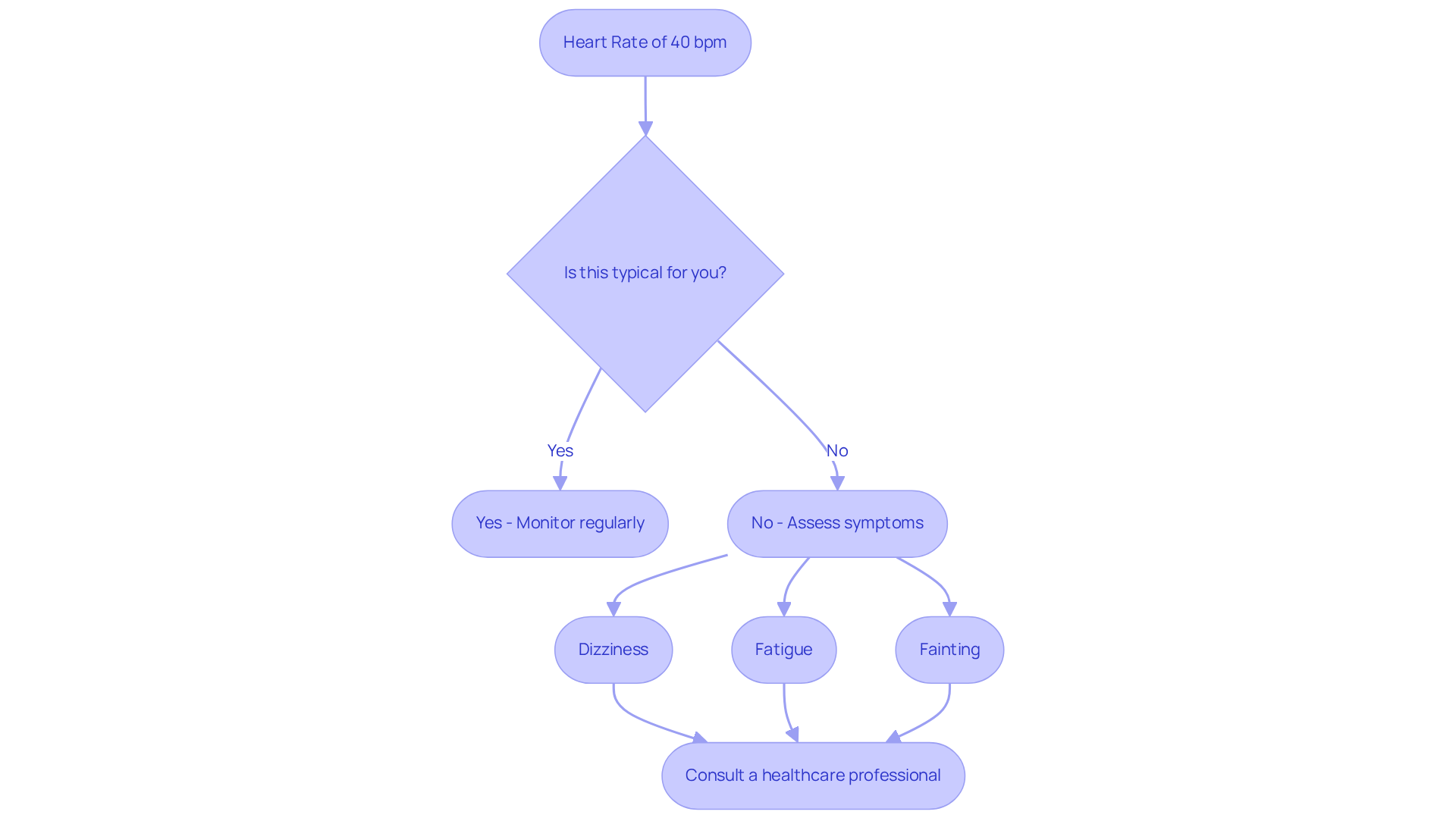


A heart rate of 40 beats per minute can understandably raise concerns, especially for those who are not athletes. This may indicate bradycardia, which can lead to symptoms such as dizziness and fatigue. It's important to recognize that while a low heart rate can be perfectly normal for well-trained athletes, it often signals underlying health issues in the general population, particularly among older adults. This highlights the necessity for careful monitoring and, if needed, a medical evaluation.
If you or a loved one is experiencing these symptoms, it's essential to seek guidance. Remember, you are not alone in this; support is available, and addressing these concerns early can lead to better health outcomes. Your well-being is a priority, and understanding your heart health is a crucial step towards feeling your best.
Understanding heart rates can be a perplexing journey, especially when encountering values that fall outside the norm. A heart rate of 40 beats per minute raises important questions about health and fitness. It straddles the line between being a potentially healthy indicator for athletes and a concerning signal for others. This article delves into the implications of such a low pulse, exploring the risks and underlying causes that could affect overall well-being.
What does a heart rate of 40 truly mean? When should it prompt a visit to the doctor? As we navigate this topic together, know that your concerns are valid and worthy of attention.
When considering a pulse of 40 beats per minute (bpm), one might wonder, is a heart rate of 40 bad, given that it is below the typical range of 60 to 100 bpm for most adults. While this slower pulse is often seen in athletes or individuals in excellent physical condition, it may also signal underlying health issues for others. For our elderly loved ones, a slow heart rate can lead to significant health implications, such as dizziness, fatigue, and even fainting. These symptoms can increase the risk of falls and other complications, which is why understanding if a heart rate of 40 is bad is so crucial.
Have you or someone you care about experienced this? It’s important to assess the potential risks and reasons behind such a pulse rate to understand if a heart rate of 40 is bad. Experts emphasize the need to observe pulse patterns closely, as both slow heartbeats and rapid pulses (exceeding 100 bpm) can indicate health concerns that warrant further examination. Regular check-ups and being aware of personal pulse trends can greatly assist in maintaining cardiovascular health and addressing any irregularities promptly.
Remember, you are not alone in this journey. Seeking help and monitoring health can make a significant difference in quality of life. If you have any concerns about your pulse or overall health, please reach out for support. Your well-being is our priority, and we are here to help you every step of the way.

A resting pulse below 60 beats per minute (bpm) is often identified as bradycardia, which leads to concerns about whether a heart rate of 40 is bad, as values falling below 40 bpm are frequently classified as severe bradycardia. For highly trained athletes, a pulse of 40 bpm can be normal, reflecting their exceptional cardiovascular fitness. However, for the typical adult, the question of whether a heart rate of 40 is bad can be concerning and may indicate underlying issues such as blockages, adverse medication effects, or other cardiac conditions. It is crucial to evaluate the pulse alongside related symptoms and the individual's overall health to accurately determine its significance.
At Amavita Heart and Vascular Health®, we prioritize comprehensive cardiac assessments to understand the implications of a low resting pulse. Current medical guidelines from cardiology associations emphasize the importance of context when evaluating bradycardia. For most healthy adults, typical resting pulse frequencies range between 60 and 100 bpm. In older individuals, a resting pulse consistently below 60 bpm should prompt further examination, especially if accompanied by symptoms like dizziness, fatigue, or shortness of breath. Our preventive cardiology approach integrates advanced risk assessment tools, lifestyle modifications, and personalized interventions to effectively address these concerns.
Additionally, a resting pulse consistently above 90 bpm should be discussed with a physician. Understanding these differences is vital for effectively managing cardiovascular health. It’s also noteworthy that only 30% of American adults engage in sufficient physical activity to maintain health and fitness, highlighting the importance of regular exercise in supporting cardiovascular well-being. Through our innovative CardioElite™ program, we offer advanced imaging and testing in one location, minimally invasive treatments, and same-day recovery options, all aimed at transforming cardiac care and enhancing patient outcomes.
We are here to support you every step of the way, ensuring your health and well-being are our top priorities.

When considering the effects on blood circulation to vital organs, one might ask, is a heart rate of 40 bad, as it can lead to concerning symptoms such as dizziness, fatigue, and fainting? These signs indicate insufficient blood flow, which can escalate into more serious complications, including cardiac arrest. It's important to note that older patients are particularly at risk. While research indicates that a slow heart rate is often seen in well-trained athletes, it raises the question of whether a heart rate of 40 is bad for individuals with existing health issues.
If you or someone you know is experiencing such low pulse rates, it is crucial to observe any additional symptoms like chest discomfort or difficulty breathing. Cardiologists recommend careful monitoring in these situations. Early intervention is vital to reduce the risks associated with prolonged bradycardia, as timely treatment can prevent serious outcomes. Understanding these implications is essential for maintaining cardiovascular health and ensuring a better quality of life.
Remember, you are not alone in this—seeking support and guidance is a strong and positive step towards better health. Your well-being matters, and taking action can lead to improved health outcomes.

It is essential to consider whether a heart rate of 40 is bad, as a pulse rate of 40 bpm can arise from various factors, making it important to understand these to ensure your health is well-managed. Age-related changes in the heart's conduction system, certain medications, and underlying health concerns can all contribute to this condition. For instance, medications like beta-blockers can lower heart rate by blocking adrenaline's effects, which may be particularly beneficial for those dealing with hypertension or heart disease. However, it’s essential to recognize that these medications can also lead to a slower heart rate, especially in older adults who might be more sensitive to their impacts.
Research shows that bradycardia is quite common among elderly patients, with studies indicating that around 15.2% of adult males and 6.9% of adult females have clinically defined bradycardia. Additionally, conditions such as hypothyroidism can slow the pulse, as thyroid hormones play a crucial role in regulating metabolism and heart function. Lifestyle factors, particularly high levels of physical fitness, can also lead to lower resting heart rates, especially in athletes.
Given these complexities, it’s vital for healthcare providers to conduct thorough evaluations to uncover the underlying causes of a slow heart rate in each individual. Treatment strategies can vary significantly based on the diagnosis, and personalized care is key. At Amavita Heart and Vascular Health, our advanced imaging capabilities and comprehensive evaluations ensure that high-risk patients, including those with diabetes and hypertension, receive tailored cardiovascular care that meets their specific needs.
Dr. Martinez-Clark, with his Harvard training and extensive cardiovascular experience, enhances the integration of these sophisticated tests into your comprehensive care plan. If you are experiencing symptoms of bradycardia, discussing your medication regimen with your healthcare provider can be crucial, particularly to address whether a heart rate of 40 is bad and if discontinuing medications that worsen this condition may lead to improvements in your symptoms. Remember, you are not alone in this journey, and we are here to support you every step of the way.

A heart rate of 40 beats per minute can understandably raise concerns, particularly as it falls below the normal range of 60 to 100 bpm. While this lower pulse may be typical for well-trained athletes, it can also signify serious health risks for others. It is essential to understand the implications of such a heart rate, especially for older adults who might experience symptoms like dizziness or fatigue. Addressing these symptoms is crucial, as they can lead to more severe complications if not managed properly.
In addition to this, the article highlights key factors contributing to a heart rate of 40, such as:
It emphasizes the importance of monitoring pulse rates and recognizing accompanying symptoms. This awareness can help determine whether medical intervention is necessary. Regular check-ups and a proactive approach to cardiovascular health can significantly mitigate the risks associated with bradycardia, ensuring timely treatment and better health outcomes.
Ultimately, awareness and education about the potential dangers of a low heart rate are vital. Are you or a loved one experiencing concerning symptoms? Seeking professional advice can lead to improved cardiovascular health and a higher quality of life. Remember, taking action can make a difference. Prioritizing heart health is not just about numbers; it’s about ensuring a healthier future for yourself and those you care about.
What does a heart rate of 40 beats per minute (bpm) indicate?
A heart rate of 40 bpm is below the typical range of 60 to 100 bpm for most adults. While it can be normal for athletes or individuals in excellent physical condition, it may also signal underlying health issues for others.
Is a heart rate of 40 bpm considered dangerous?
Yes, a slow heart rate can lead to significant health implications, especially in elderly individuals. It may cause symptoms such as dizziness, fatigue, and fainting, increasing the risk of falls and other complications.
What should one do if they or someone they care about has a heart rate of 40 bpm?
It is important to assess potential risks and reasons behind such a pulse rate. Observing pulse patterns closely and consulting with a healthcare professional for further examination is recommended.
Why is it essential to monitor heart rate patterns?
Monitoring heart rate patterns is crucial because both slow heartbeats (like 40 bpm) and rapid pulses (exceeding 100 bpm) can indicate health concerns that may require further evaluation.
How can one maintain cardiovascular health?
Regular check-ups and being aware of personal pulse trends can greatly assist in maintaining cardiovascular health and addressing any irregularities promptly.
What should someone do if they have concerns about their pulse or overall health?
If there are concerns about pulse rate or overall health, it is advisable to reach out for support and seek help from healthcare professionals.